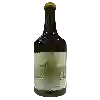
Caveau du Vieux PressoirCôtes du Jura Savagnin
In the mouth this white wine is a with a nice freshness.
This wine generally goes well with poultry, mild and soft cheese or mushrooms.
Taste structure of the Côtes du Jura Savagnin from the Caveau du Vieux Pressoir
Light | Bold | |
Dry | Sweet | |
Soft | Acidic |
In the mouth the Côtes du Jura Savagnin of Caveau du Vieux Pressoir in the region of Jura is a with a nice freshness.
Food and wine pairings with Côtes du Jura Savagnin
Pairings that work perfectly with Côtes du Jura Savagnin
Original food and wine pairings with Côtes du Jura Savagnin
The Côtes du Jura Savagnin of Caveau du Vieux Pressoir matches generally quite well with dishes of poultry, mushrooms or mild and soft cheese such as recipes of cauliflower croque-monsieur, risotto with ceps (italy) or savoyard fondue.
Details and technical informations about Caveau du Vieux Pressoir's Côtes du Jura Savagnin.
Discover the grape variety: Téoulier
Téoulier noir is a grape variety that originated in France (Provence). It produces a variety of grape specially used for wine making. It is rare to find this grape to eat on our tables. It can be found in several vineyards: South-West, Cognac, Bordeaux, Provence & Corsica, Rhone Valley, Loire Valley, Savoie & Bugey, Beaujolais.
Informations about the Caveau du Vieux Pressoir
The Caveau du Vieux Pressoir is one of of the world's greatest estates. It offers 11 wines for sale in the of Côtes du Jura to come and discover on site or to buy online.
The wine region of Côtes du Jura
Côtes du Jura is a regional appellation in the Jura wine region of eastern France. Introduced in 1937, it is arguably the largest appellation in the region in terms of geographical extent. In terms of quantity, it is the second largest after Arbois">Arbois. While the vast majority of Jura wines are produced in the Northern half of the region between Etoile and Arbois, the Côtes du Jura catchment area extends some distance to the South.
The wine region of Jura
The Jura is a small wine region in eastern France that is responsible for some very special and traditional wine styles. It is close to the Swiss Jura, but quite distinct from it. Wedged between Burgundy to the west and Switzerland to the east, the region is characterized by a landscape of Wooded hills and the winding topography of the Jura Mountains. The Jura vineyards cover just over 1,850 hectares, forming a narrow strip of land almost 80 km Long from North to South.
The word of the wine: Acescence
An alteration in wine also known as pitting (hence the expression piqué wine), due to the presence of acetic acid and ethyl acetate, and characterized by a vinegar-like odor.














